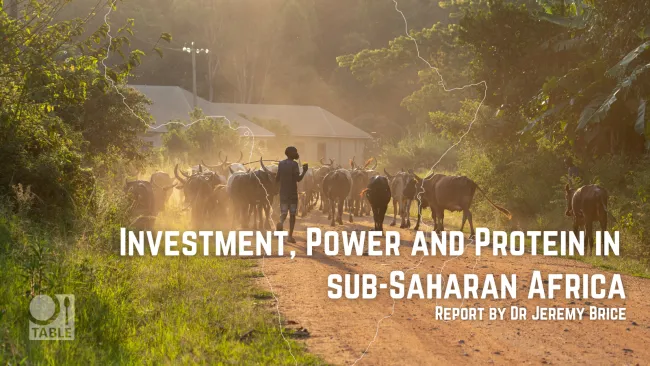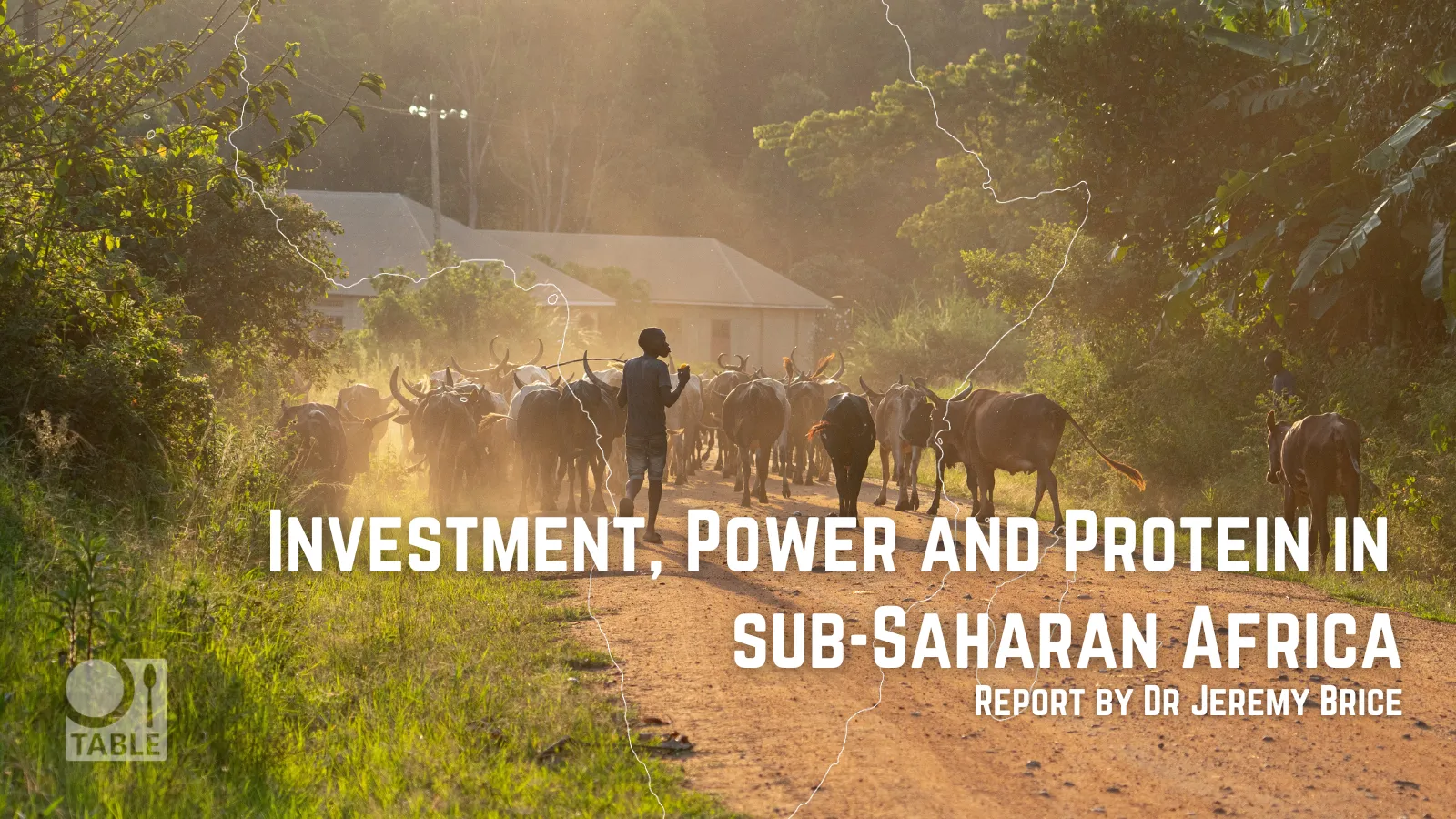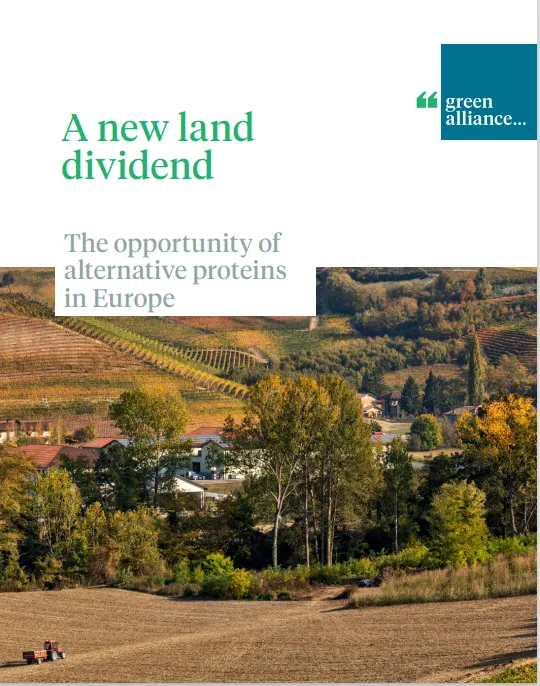Investment, Power and Protein in sub-Saharan Africa:
- Introduction
- Background
- Research Methodology
- Sub-Saharan Africa’s Agricultural Investment Landscape
- Investor Visions
- National Subsidies and Global Market
- Conclusions
- Glossary
Suggested citation:
Brice, J., (2022) Investment, Power and Protein in sub-Saharan Africa. TABLE Reports. TABLE, University of Oxford, Swedish University of Agricultural Sciences and Wageningen University and Research. doi.org/10.56661/d8817170
< Previous: Section 4 Next: Investor visions - I >
Summary
- This chapter presents the findings of expert interviews conducted during phase 2 of the project. These interviews were intended to establish what expectations about the future, and what financial and/or normative goals, motivate different groups of investors to finance protein production in sub-Saharan Africa. They were also designed to provide insight into which protein sources and production systems each group of investors prefers to finance, and into the theories of change which make them believe that making these investments will contribute to achieving their goals.
- All interviewees expected that over the coming decades economic growth and urbanisation within many sub-Saharan African countries would produce a significant increase in demand for protein across the region. As a result, they acted in the belief that rapid increases in protein consumption in sub- Saharan Africa over the coming decades were inevitable, and that their organisations should therefore invest in those activities which would satisfy this future ‘need’ or ‘demand’ for protein most effectively.
- However, different groups of investors were motivated by contrasting goals and values which led them to varying conclusions about what type of protein should be produced in order to satisfy this future need and about how and by whom it should be produced. This produced three distinct visions for the future of African food systems – which this report terms Smallholder Intensification, Protein for Profit and Protein Diversification.
- While the Smallholder Intensification and Protein for Profit visions did overlap under some circumstances, in most cases proponents of different visions tended to invest in different protein value chains, production systems and geographical locations.
- This chapter examines each vision in turn, describing who pursues and finances it, why they do so, what locations, products and value chain stages they tend to invest in, and how they expect their investments to bring about the future outcomes that they desire. Due to the richness of this material, separate summary boxes are provided at the beginning of the section dealing with each of these visions.
This chapter presents the findings of interview research conducted during the second phase of the project. Building on the results of the desk research presented in Chapter 4, the author sought interviews with representatives of key groups of agricultural investors as well as other individuals likely to possess a detailed understanding of the motives and investment decision making processes of organisations with investments in protein production in sub-Saharan Africa. These interviews were intended to establish what expectations about the future, and what financial and/or normative goals, motivated different groups of investors to finance protein production in sub-Saharan Africa. They also explored which protein sources and production systems each group of investors prefers to finance, and what theories of change make them believe that making these investments will contribute to achieving their goals.
The chapter begins by examining interviewees’ expectations about the future of protein in sub-Saharan Africa, highlighting that all interviewees expected demand for animal protein to expand rapidly in sub-Saharan Africa over the coming decades and therefore believed that sub-Saharan African countries would ‘need’ to produce more protein. However, different groups of investors’ contrasting beliefs and objectives led them several different understandings of what type of protein should be produced in order to satisfy this need, of how and by whom it should be produced and, as a result, of which protein sources and production systems they should invest in. The main body of this chapter therefore describes three distinct investor ‘visions’ for the future of protein in sub-Saharan Africa, and the prescriptions for investment which flow from them.
Expecting Nutritional Transitions
Interviewees expected without exception that over the coming decades economic growth within many sub- Saharan African countries would cause protein-rich foodstuffs to assume an increasingly prominent place in the diets of their citizens and thus produce a significant increase in average protein consumption per person across the region. In some cases they justified these expectations by referring explicitly to academic research which forecast, based on the nutritional transition models introduced in Chapter 2, that demand for protein would at least double across the continent of Africa by 2050. Interviewees typically presented this close correlation between population expansion, GDP growth and increasing consumption of protein-rich foodstuffs as an unalterable fact and often characterised consumer preferences for higher-protein foodstuffs as being innate and therefore not susceptible to modification. This led them to conclude that rapid increases in protein consumption in sub-Saharan Africa over the coming decades were inevitable.
“As you know the protein demand increase [is] driven by (...) per capita income, urbanisation and food preferences. The African continent’s going to be where that protein [demand] is going to increase disproportionately – 168% by 2050 or something is the stats that I’ve seen forecast. And if the demand is going to come [from] there, you know, we cannot increase the supply at the current productivity levels. You need to increase unit productivity.”
(Interview 07, philanthropic foundation)
This suggests that the nutritional transition model has, for many investors, transformed from being a description of past economic and dietary changes in other parts of the world into a set of predictions about the future of food in sub-Saharan Africa which they consider sufficiently credible to use as a basis for their investment decision-making. In essence, they act in the expectation that the future development of sub-Saharan African economies and diets will broadly repeat patterns of change previously observed in Europe, North America and (increasingly) in Asia and Latin America. Most interviewees therefore began from a presumption that the future of food in sub-Saharan Africa would be characterised by a rapidly growing ‘need’ or ‘demand’ for more protein, and that their organisations should therefore invest in those activities which would satisfy this need most effectively. Alternative possibilities were typically either dismissed as implausible or not considered at all, casting increased investment in the production of protein on the continent as an unavoidable necessity.
Despite this broad agreement that there is a ‘need’ for sub-Saharan African countries to produce more protein in order to meet this future demand, interviewees held several different understandings of what type of protein should be produced in order to satisfy this need and of how and by whom it should be produced. Analysis of the interview material identified three distinct visions for the future of African food systems, which this report terms Smallholder Intensification, Protein for Profit and Protein Diversification (whose main characteristics are summarised in Table 1). These visions were held by distinct groups of investors motivated by differing goals and values which led them to focus their investments on different protein value chains, production systems and geographical locations, and appeared to be intended to generate contrasting systems of protein production and provisioning. The Smallholder Intensification vision was prevalent among DFIs, philanthropic organisations and impact investors whose investments were intended to reduce poverty and malnutrition – and to facilitate sustainable development – by providing smallholder farmers and pastoralists with access both to high-quality agricultural inputs and to higher-value markets for their produce. By contrast, the Protein for Profit vision expresses the values and goals of private equity funds and commercial banks which aim simply to produce a competitive financial return on their clients’ investments through investing in animal protein (and specifically poultry and egg) production. Finally, the Protein Diversification vision was held by a distinct group of venture capital investors who were motivated by concerns over the environmental impacts and ethical desirability of expanding sub-Saharan Africa’s livestock sector and sought instead to satisfy expected future demand for protein through financing manufacturers of alternative protein products.
This chapter examines each of these visions in turn, outlining who pursues and finances it, why they are motivated to do so, what locations, products and value chain stages they tend to invest in, and how they expect their investments to bring about the future outcomes that they desire. Because reliable data on the quantities of capital invested in African agriculture is scarce (as discussed in the previous chapter), and because evaluating the impacts of these investments on agricultural production and diets in sub-Saharan Africa would both be intellectually difficult and demand more resources than were available to this project, this report simply describes these visions. It does not attempt to measure the size of the financial flows mobilised by their proponents, to determine how successful their adherents have been in achieving their goals or to assess the magnitude of their impact on sub-Saharan African food systems.
Table 1: Three Investor Visions
| Smallholder Intensification | Protein for Profit | Protein Diversification |
Key Investors | Development; Finance; Institutions; Philanthropic organisations; Impact funds | Private equity funds; Commercial banks | ‘Vegan’ venture capital funds |
Financial instruments used | Grants, loans, and equity investments | Loans and equity investments | Equity investments |
Objectives | Reduce poverty among smallholder farmers and pastoralists; Reduce malnutrition: Ensure environmental sustainability | Produce market-competitive rates of return on investment; Secure a dominant position in sub- Saharan Africa’s growing animal protein sector | Enable the mainstreaming of alternative proteins into sub-Saharan African diets; Produce market-competitive rates of return on investment |
Intended beneficiaries | Smallholder farmers and pastoralists | Individuals and organisations which invest capital in financial institutions | Consumers and the environment |
Central problems to be addressed | Low agricultural productivity; Poverty, hunger and malnutrition among smallholder farmers and pastoralists; Lack of access to markets | Dependence on feed, meat & dairy imports; Lack of formal markets for high quality animal products | Environmental and animal welfare impacts of livestock agriculture; Limited availability of affordable alternative protein products |
Factors enabling change | Investment in high quality animal feed, veterinary medicines and breeding stock; Investment in connections to markets via cooperatives and processors | GDP growth and urbanisation; Increasing presence of retail and restaurant chains in sub-Saharan Africa | Investment in scaling up production; Achievement of price parity between alternative proteins and animal products |
Preferred value chains | Poultry and eggs, dairy, aquaculture | Poultry and eggs, dairy (processing only) | Alternative proteins (plant-based and in vitro meat and milk alternatives) |
Value chain stages financed | Agricultural input suppliers; Aggregators and processors | Agricultural input suppliers; Vertically integrated poultry and egg farms; Aggregators and processors | Alternative protein manufacturers |
Geographical focus | Ethiopia, Uganda, Tanzania, Kenya, Zambia, Mozambique, Malawi, Nigeria, Ghana | South Africa, Zambia, Kenya, Uganda, Nigeria, Tanzania | South Africa, Kenya, Nigeria, Ghana |
Intended impact on livestock agriculture | Productivity of animals increases but livestock populations remain static; Smallholders and pastoralists remain the primary livestock producers | Livestock productivity and populations increase; Shift from backyard to intensive livestock production where this is profitable | Alternative protein production and consumption increases; Livestock populations remain static or expand only slightly |





Comments (0)